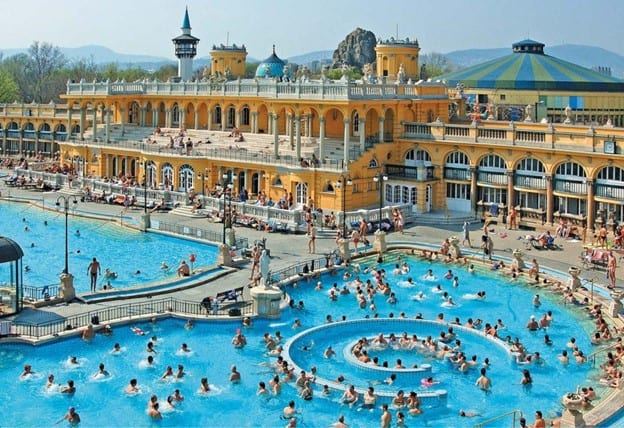Baths in Budapest: A Guide to the City’s Best Thermal Spas
Budapest, the capital city of Hungary, is known for its thermal baths and spas. The city has a rich history of thermal bathing, dating back to the Roman times. The hot springs of Budapest are believed to have healing properties, and the locals have been using them for centuries to treat various ailments.
Budapest has over 100 thermal springs, and the water is rich in minerals like calcium, magnesium, and sulfate. The thermal baths in Budapest are not just for relaxation but also for therapeutic purposes. The water is believed to have many health benefits, including improving circulation, reducing stress, and relieving joint pain.
Visitors to Budapest can choose from a wide range of thermal baths, each with its unique features and history. Some of Budapest’s most famous thermal baths include Széchenyi, Gellért, and Rudas. These baths offer various services like saunas, aquafitness, and aerobics, making them ideal for anyone looking for a relaxing and rejuvenating experience.
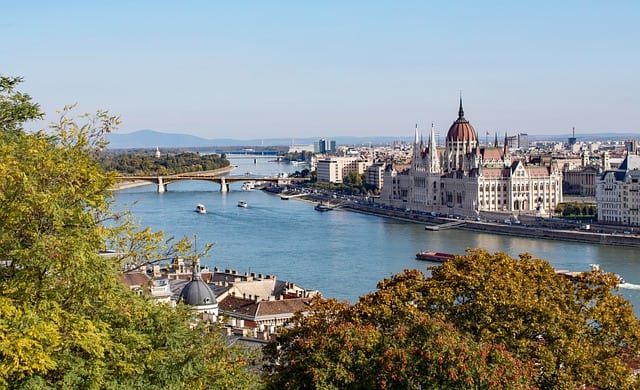
This post may contain affiliate links. Please read our disclosure and privacy policy for more information.
A Soak in History: The Origins of Budapest’s Thermal Baths

Budapest’s thermal baths have roots that stretch back over two millennia. The city’s thermal waters were first recognized for their healing properties during the Roman era, as evidenced by archaeological findings. The Turks, who occupied Budapest in the 16th and 17th centuries, further contributed to developing the city’s bathing culture. The fusion of these historical influences has given rise to the unique thermal bath landscape we see today. Also, with its wonderful thermal baths, Budapest (the other capital of the late 19th century Austro-Hungarian Empire) is just a short train ride away! Perfect for a weekend visit.
Budapest’s thermal baths are not merely recreational; they are living artifacts that tell the story of the city’s resilience and adaptability over the centuries. As you immerse yourself in the warm waters of these baths, it’s as if you’re taking a dip into the pages of Budapest’s vibrant history.
History of Bathing in Budapest
Budapest has a rich history of thermal baths that dates back to the Roman era. Over the centuries, the city has been influenced by various cultures, including the Ottoman Empire, which left its mark on its bathing culture. Today, Budapest is known as the “City of Spas,” with over 100 thermal springs and 15 public baths.
The architectural grandeur of Budapest’s thermal baths goes beyond mere functionality; it reflects a commitment to creating visually stunning and culturally significant spaces. Gellért’s Art Nouveau design, with its intricate details and statues depicting mythological scenes, transports visitors to a time when bathing was not just a routine but a ritual.
Széchenyi’s Neo-Baroque building, adorned with majestic sculptures and colonnades, pays homage to Hungary’s rich artistic heritage. The elegant design and thermal indulgence create an immersive experience that resonates with the city’s cultural identity. With its Ottoman-inspired architecture, Rudas combines historic charm and contemporary comfort, showcasing Budapest’s ability to preserve and evolve simultaneously.

Exploring these architectural marvels is akin to strolling through an open-air museum. Each bath tells a story of the past while inviting you to participate in the present.
Roman Era Baths
The Romans were the first to discover Budapest’s thermal springs and built the city’s first bathhouses. The remains of these ancient baths can still be seen today, including the ruins of the Aquincum Baths, which were made in the 2nd century AD. The Romans believed in the healing properties of the thermal waters and used them for both relaxation and medicinal purposes.
Ottoman Influence
In the 16th century, Budapest was occupied by the Ottoman Empire, which brought with it the tradition of Turkish baths. The Ottomans built several bathhouses in the city, including the Király Baths, the Rudas Baths, and the Veli Bej Baths, which are still in use today. These baths were built in the traditional Ottoman style, with domed roofs, marble columns, and intricate tilework.
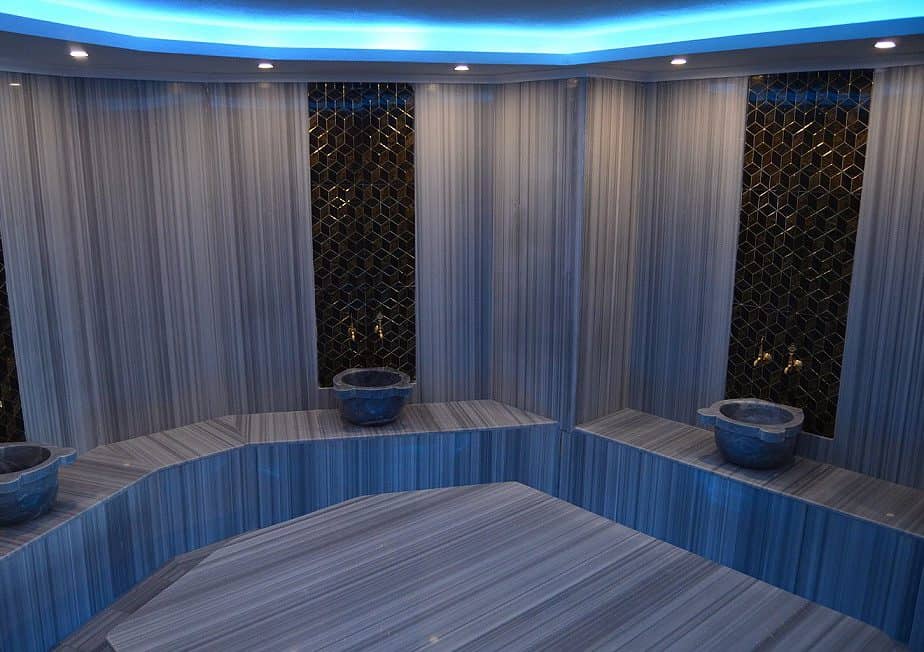
Modern Developments
In the 19th and 20th centuries, Budapest underwent a period of modernization and expansion, leading to the construction of several new bathhouses. The Széchenyi Baths, one of the most famous thermal baths in the city, was built in the early 20th century and features a neo-baroque style. The Gellért Baths, located in the Gellért Hotel, were made in the Art Nouveau style and are known for their beautiful mosaics and stained glass windows.
Today, Budapest’s thermal baths are a popular tourist attraction, drawing visitors from all over the world to experience the healing properties of the thermal waters and the city’s rich cultural history.
Architectural Styles
Budapest is home to several thermal baths that boast unique architectural styles, ranging from Art Nouveau to Classical and Neo-Baroque.
Art Nouveau Design
The Gellért Thermal Bath is one of the most famous baths in Budapest, featuring Art Nouveau design. This style is characterized by its decorative and ornamental motifs and its use of curved lines and asymmetrical forms. The Gellért Thermal Bath’s interior is adorned with stained glass windows, mosaics, and sculptures, all typical of Art Nouveau’s design.
Classical and Neo-Baroque
The Széchenyi Thermal Bath is another famous thermal bath in Budapest, and it features Classical and Neo-Baroque designs. This style is characterized by its grandeur, symmetry, and use of decorative elements such as columns, pediments, and statues. The Széchenyi Thermal Bath’s exterior is adorned with sculptures and reliefs, while its interior features ornate frescoes and marble columns.
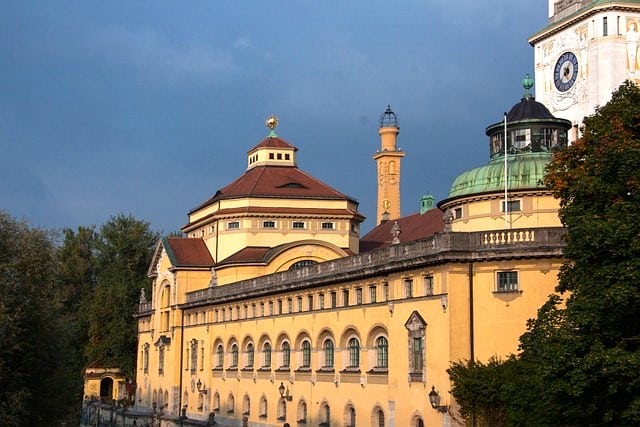
The Lukács Thermal Bath is another Budapest thermal bath with a Classical design. The building was constructed in the 1880s and features a mansion-like exterior with a grand entrance—the Lukács Thermal Bath’s interior features ornate frescoes and marble columns, typical of Classical design.
The Four Most Famous Thermal Baths
Budapest is famous for its thermal baths, attracting visitors for centuries. Here are some of the most famous thermal baths in Budapest:
Visiting these thermal baths is a must-do activity while in Budapest. Each tub has its unique features and charm, making it an excellent experience for visitors of all ages.
Gellért Baths: Where Tradition Meets Elegance
Gellért Thermal Bath was built in the Gellért Hotel in 1918. The bath is known for its Art Nouveau architecture, indoor and outdoor pools, and various saunas and steam rooms. The water temperature ranges from 26 to 40 degrees Celsius, and the mineral-rich water is believed to have healing properties. The bath also offers massages and other treatments.
The Gellért Baths are a true masterpiece in Budapest’s many thermal baths. Nestled on the Buda side of the city, Gellért Baths boasts an Art Nouveau design that seamlessly blends tradition with elegance. The complex, named after Saint Gellért, a martyr bishop, features indoor and outdoor pools, ornate mosaics, and sculptures that pay homage to Hungary’s cultural and religious heritage.

Exploring Gellért Baths is not just about the thermal waters; it’s about immersing yourself in a visual and sensory experience. The iconic wave pool, surrounded by towering pillars and intricate tilework, creates an ambiance that transcends the ordinary. Visitors can indulge in various services, from therapeutic massages to traditional Hungarian spa treatments, making the Gellért Baths a haven for relaxation and cultural appreciation.
Széchenyi Baths: Budapest’s Largest and Most Popular Spa Complex
Széchenyi Thermal Bath is one of Budapest’s largest and most famous thermal baths. It was built in 1913 and is located in the City Park. The bath is known for its neo-Baroque architecture, 15 indoor pools, three outdoor pools, and various saunas and steam rooms. The water temperature ranges from 28 to 40 degrees Celsius, and the mineral-rich water is believed to have healing properties.
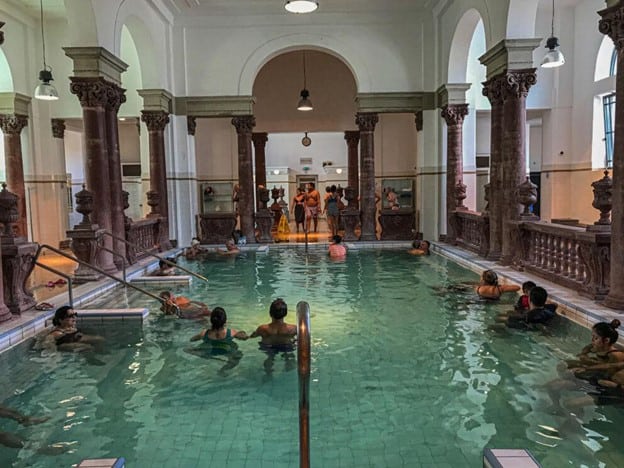
Situated in the heart of the City Park, Széchenyi Baths claim the title of Budapest’s largest and most visited thermal spa complex. The grandeur of Széchenyi is immediately apparent as you approach the Neo-Baroque building. The sprawling outdoor area, with its numerous pools of varying temperatures, provides a communal space for locals and tourists alike to unwind and socialize.
Széchenyi Baths offers a unique blend of relaxation and recreation. Whether you’re soaking in the thermal waters, playing chess with locals in the outdoor pools, or attending one of the many events hosted within the complex, Széchenyi Baths exemplify the lively spirit of Budapest’s bathing culture. The therapeutic benefits of the mineral-rich waters add to the allure, making it a must-visit destination for those seeking wellness and entertainment.
Széchenyi Baths also offer a beer spa where you can soak in a tub of beer!

Rudas Baths: An Ottoman Oasis in the Heart of Budapest
Rudas Baths is a historic thermal bath built in the 16th century during the Ottoman rule of Hungary. The tub is known for its Turkish-style architecture, octagonal pool, and various saunas and steam rooms. The water temperature ranges from 16 to 42 degrees Celsius, and the mineral-rich water is believed to have healing properties. The bath also offers rooftop pools with panoramic views of the city.
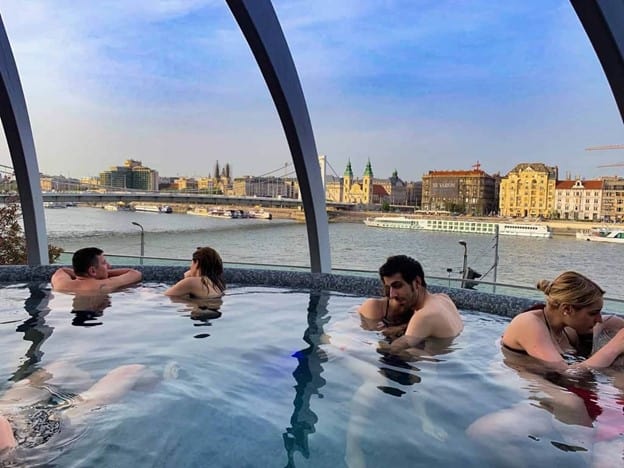
For a journey back in time to Budapest’s Ottoman era, Rudas Baths provides an authentic and rejuvenating experience. The octagonal pool, with its stunning dome and natural light filtering through, creates an ambiance reminiscent of a bygone era. Rudas seamlessly blends the historical charm of Turkish architecture with modern facilities, offering visitors a unique thermal escape.
One of Rudas Baths’ distinctive features is the rooftop pool, which provides panoramic views of Budapest’s skyline. The juxtaposition of ancient and contemporary elements is palpable, offering a tranquil space for relaxation and contemplation. The thermal waters of Rudas are believed to have medicinal properties, adding a therapeutic dimension to the overall experience.
Király Baths
Király Baths is another historic thermal bath built in the 16th century during the Ottoman rule of Hungary. The tub is known for its Turkish-style architecture, octagonal pool, and various saunas and steam rooms. The water temperature ranges from 26 to 40 degrees Celsius, and the mineral-rich water is believed to have healing properties. The bath also offers massages and other treatments.

Image Credit: Budapest Org
Secret Thermal Hideaways: Lesser-Known Gems
While Gellért, Széchenyi, and Rudas take the spotlight, Budapest harbors lesser-known thermal gems that offer a more intimate and local experience. Lukács Baths, tucked away on the Buda side, exude a laid-back atmosphere and are favored by locals seeking a quieter retreat. Király Baths, with its Ottoman architecture and octagonal pool, provides a historical and therapeutic escape off the beaten path.
Exploring these hidden treasures allows you to witness Budapest’s bathing culture in its most authentic form. The smaller crowds and the healing properties of the thermal waters make these lesser-known baths a sanctuary for relaxation and introspection.
Popular Tours And Entry To Baths In Budapest
Beyond Bathing: Wellness and Relaxation in Budapest
Budapest’s thermal baths transcend the traditional concept of mere bathing; they serve as wellness hubs, offering myriad services to cater to both body and mind. From invigorating massages to yoga classes set against the backdrop of stunning architecture, these baths provide holistic experiences for visitors.
The healing properties of the thermal waters have long been acknowledged, and Budapest’s baths have embraced this aspect by incorporating wellness programs that cater to various needs. Whether you seek physical rejuvenation, mental relaxation, or a combination, Budapest’s thermal baths offer diverse services to meet your wellness goals.
Bathing Culture in Hungarian Society
Bathing culture is deeply ingrained in Hungarian society and is believed to have therapeutic benefits for both physical and mental health. The thermal waters in Budapest are rich in minerals like calcium, magnesium, and sulfur, which are said to help with various ailments such as arthritis, joint pain, and skin conditions. Many Hungarians visit the baths regularly as a form of preventative healthcare.
Bathing in Budapest is a leisure activity and a cultural experience. The architecture of the baths, which range from Art Nouveau to Neo-Baroque styles, is a testament to the city’s history and cultural heritage. Visitors to Budapest can immerse themselves in this unique aspect of Hungarian culture by visiting one of the many thermal baths scattered throughout the city.

Beyond the therapeutic benefits and architectural wonders, Budapest’s thermal baths serve as vibrant social hubs where locals and visitors converge. Széchenyi’s outdoor pools, surrounded by chess boards, become lively arenas where bathers engage in friendly matches, creating a unique blend of relaxation and social interaction. Gellért’s wave pool, while serene, fosters a sense of community as bathers share stories and experiences.
Participating in these communal activities not only enhances the overall bathing experience but also provides a glimpse into the social fabric of Budapest. The thermal baths, traditionally seen as places of healing, have evolved into dynamic spaces where people from all walks of life come together, forging connections amidst the soothing waters.
Seasonal Splendor: Budapest’s Thermal Baths Through the Year
The allure of Budapest’s thermal baths undergoes fascinating transformations with each season. In the winter, Széchenyi’s outdoor pools offer a surreal experience as steam rises into the cold air, creating an ethereal atmosphere. Gellért’s indoor pools become cozy retreats, shielding bathers from the winter chill while allowing them to bask in the therapeutic warmth of the thermal waters.
During the summer, the outdoor spaces of the baths come alive with the laughter and chatter of visitors seeking relief from the heat. Széchenyi’s expansive sunbathing area becomes a sun-soaked haven, and Rudas’s rooftop pool offers a refreshing escape with panoramic city views. Exploring Budapest’s thermal baths in different seasons adds a layer of diversity to the experience, making each visit a unique and memorable adventure.
Spa Cuisine: Indulging the Palate in Budapest’s Baths
No exploration of Budapest’s thermal baths is complete without indulging in the culinary delights offered within these spa complexes. Gellért’s café, with its Art Nouveau charm, provides a perfect setting for a leisurely coffee or a light meal. Széchenyi’s dining options range from casual snacks to gourmet experiences, allowing bathers to savor Hungarian cuisine without leaving the premises.
Integrating gastronomy into the thermal bath experience adds a sensory dimension, allowing visitors to pamper their taste buds and bodies. From traditional Hungarian dishes to international flavors, Budapest’s thermal baths offer a gastronomic journey that complements the overall indulgence of a day spent in thermal relaxation.
Healing Waters: Medicinal Properties of Budapest’s Thermal Baths
Central to the allure of Budapest’s thermal baths are the mineral-rich waters renowned for their therapeutic properties. The composition of these waters, containing minerals such as calcium, magnesium, and sulfates, is believed to alleviate various ailments, including joint pain, respiratory issues, and skin conditions. As you soak in the warm embrace of the thermal waters, you’re not just engaging in a leisure activity but partaking in a centuries-old tradition of holistic healing.
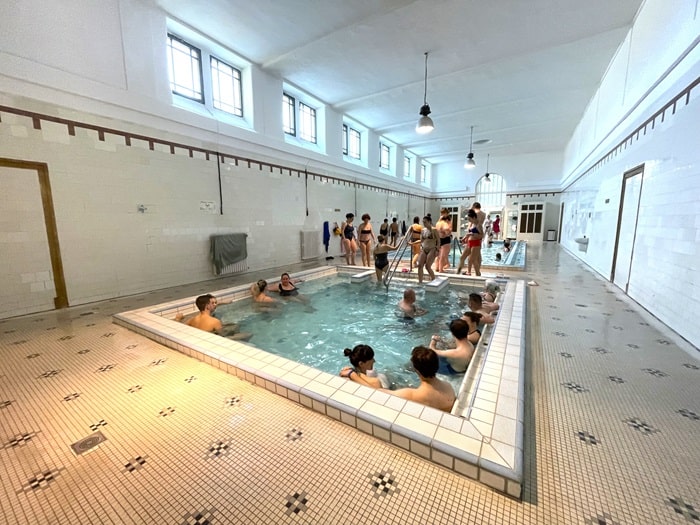
Many of Budapest’s thermal baths offer specialized treatments harnessing the waters’ healing powers. From medicinal mud packs to underwater jet massages, these therapeutic interventions provide a holistic approach to well-being, combining the physical benefits of the thermal waters with targeted wellness practices.
The Nightlife of Baths: Budapest After Sundown
As the sun sets over Budapest, the thermal baths transform into enchanting havens bathed in ambient light. Széchenyi, in particular, becomes a nocturnal retreat during the summer months, hosting spa parties that blend music, dance, and relaxation. Gellért’s night bathing sessions offer a serene ambiance, allowing bathers to unwind under the starlit sky.
Experiencing Budapest’s thermal baths after sundown provides a different perspective, where the play of light and shadow accentuates the architectural beauty, and the tranquil atmosphere takes on a more magical quality. The nightlife of Budapest’s baths is a testament to the versatility of these spaces, catering to those seeking both daytime tranquility and nighttime revelry.
Practical Information
Best Time to Visit
The best time to visit Budapest’s thermal baths is during the shoulder season, from March to May or September to November when the crowds are thinner, and the weather is mild. The peak season is during the summer months, from June to August, when the temperatures can get very hot, and the baths can get overcrowded. The winter months, from December to February, are also an excellent time to visit if you don’t mind the cold weather.
Admission and Fees
The admission fees for Budapest’s thermal baths vary depending on the tub and the time of day. The most famous bath, Széchenyi, charges 6,800 HUF (about $22) for a weekday full-day ticket and 7,300 HUF (about $24) on weekends. Gellért Bath charges 6,700 HUF (about $22) on weekdays and 7,200 HUF (about $24) on weekends for a full-day ticket. Rudas Bath charges 4,800 HUF (about $16) on weekdays and 5,300 HUF (about $18) on weekends.
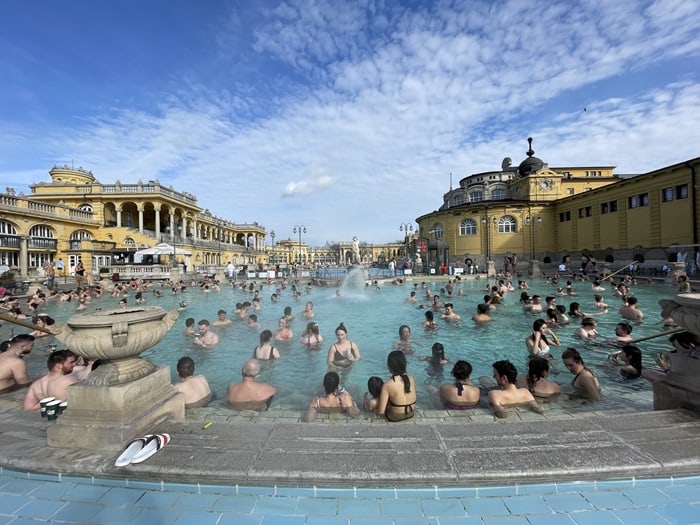
Amenities and Services
Most of Budapest’s thermal baths offer a range of amenities and services, including lockers, towels, and bathing suits for rent. Some baths also offer massages, spa treatments, and other wellness services for an additional fee. Visitors should note that some baths, such as Rudas Bath and Király Bath, are gender-segregated, with separate sections for men and women. Visitors should also be aware that some baths, such as Széchenyi Bath, can get very crowded, especially on weekends and during peak season, so arriving early is a good idea to avoid crowds.
Guidelines and Etiquette
When visiting the thermal baths in Budapest, there are a few guidelines and etiquette to follow to ensure a pleasant experience for everyone.
First and foremost, it is essential to remember that nudity is not allowed in the public areas of the thermal baths. Visitors must wear swimwear, except in the showers, where nudity is allowed.
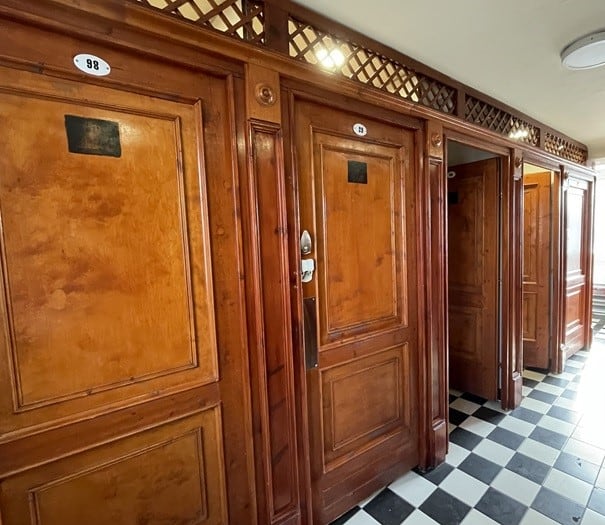
It is also essential to keep the noise level to a minimum. While chatting is allowed, visitors should be mindful of others who are there to relax and unwind. Additionally, visitors should avoid running or splashing in the pools to prevent accidents or injuries.
Visitors should follow the instructions and guidelines provided by the staff when using the facilities. This includes using lockers to store personal belongings, showering before entering the pools, and not bringing food or drinks.
Finally, visitors should respect the cultural significance of the thermal baths in Budapest. These baths have been a part of the city’s history and culture for centuries, and visitors should treat them with the respect they deserve.
Following these guidelines and etiquette allows visitors to enjoy a relaxing and rejuvenating experience at the Budapest thermal baths.
FAQs
What to wear to thermal baths in Budapest

Bathing caps are worn in the swimming pools, but these can be rented for those who wish to take a dip. Saunas are generally mixed, and swimsuits are kept on, although the rule has some exceptions. Whatever the case, take in your towel to sit on for hygiene reasons.
Why does Budapest have thermal baths?

It has to do with what lies beneath the city. Bubbling underneath the city is a massive springwater reserve that produces 70 million liters of thermal water daily.
Can you go to the thermal baths in Budapest in December?

Yes, most of the Budapest Baths are open throughout the year, including winter.
What is the most famous thermal bath in Budapest?

Szechenyi Bath is the biggest and most famous thermal bath in Budapest.
The 18 pools in Szechenyi Bath are open every day throughout the year, including national holidays when it’s a trendy place to visit.
How do I purchase tickets for Széchenyi Thermal Bath?

Visitors can purchase tickets for Széchenyi Thermal Bath online or at the entrance. It is recommended to buy tickets online in advance to avoid long queues. The tickets grant full-day access to the bath and include lockers or cabins to store personal belongings.
Are the thermal baths in Budapest maintained with cleanliness and hygiene?

Yes, the thermal baths in Budapest are maintained with cleanliness and hygiene. The baths are regularly cleaned and disinfected to ensure a safe and hygienic experience for visitors. It is also recommended to shower before entering the pools to maintain cleanliness.
Is there an option to experience thermal baths in Budapest at no cost?
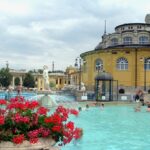
No, there is no option to experience thermal baths in Budapest at no cost. However, some baths offer discounted tickets for students or senior citizens. Visitors can also purchase Budapest Cards that provide discounts on various attractions, including thermal baths.
Closing Thoughts: Budapest’s Thermal Baths – A Timeless Tapestry
In conclusion, exploring the thermal wonders of Budapest goes beyond the act of bathing; it is an immersive journey through history, architecture, culture, and well-being. From the architectural splendor of Gellért to the communal spirit of Széchenyi, the medicinal embrace of Rudas, and the hidden gems waiting to be discovered, Budapest’s thermal baths create a timeless tapestry that weaves together the past and present.
From the Roman origins to the Ottoman influences and the modern-day fusion of tradition and elegance, Budapest’s thermal baths offer a journey through time and a celebration of the city’s resilience. So, let the warm embrace of the thermal waters envelop you as you explore the bathing capitals of Budapest, where every ripple in the pool echoes the history and vitality of this enchanting city.
As you submerge yourself in the warm waters, engage in social interactions, savor spa cuisine, and embrace the healing properties, you become part of a tradition that has endured for centuries. Budapest’s thermal baths invite you to bathe and connect with the city’s soul, experience its cultural richness, and find rejuvenation in the therapeutic embrace of its mineral-rich waters. So, whether you’re a history enthusiast, architecture lover, or wellness seeker, Budapest’s thermal baths offer an all-encompassing experience that transcends the ordinary and immerses you in the extraordinary.
Author Bio
Prince is an adventurous and avid travel writer passionate about exploring the world’s most captivating landscapes. With a background in geography and a deep love for the outdoors, Prince has dedicated ten years to exploring the beauty of the earth.
Looking For More? Start Here:
- 10 Austrian Cities To Explore On A Budget
- 10 Unforgettable Things To See In Normandy
- Vienna, Austria – the Best Things to See & Do
- Italy’s Secret to Happiness
- Kahler Luxembourg – The Farming Village With Graffiti Murals
- Laguna Thermal Resort & Spa, Turkey
- Romania – The Best Tourist Attractions
- Walker’s Haute Route: The Best Hiking Guide
- Useldange Castle, Luxembourg
We participate in the Amazon Services LLC Associates Program, an affiliate advertising program designed to provide a means for us to earn fees by linking to Amazon.com and affiliated sites.
Brit On The Move™ Travel Resources
Ready to book your next trip? Use these resources that work:
Was the flight canceled or delayed? Find out if you are eligible for compensation with AirHelp.
- Book your Hotel: Find the best prices; use Booking.com
- Find Apartment Rentals: You will find the best prices on apartment rentals with Booking.com’s Apartment Finder.
- Travel Insurance: Don’t leave home without it. View our suggestions to help you decide which travel insurance is for you: Travel Insurance Guide.
- Want to earn tons of points and make your next trip accessible? Check out our recommendations for Travel Credit Cards.
- Want To Take A Volunteer Vacation or a Working Holiday? Check out the complete guide to how here!
- Want to Shop For Travel Accessories? Check out our Travel Shop.
Need more help planning your trip? Visit our Resources Page, which highlights the great companies we use for traveling.
